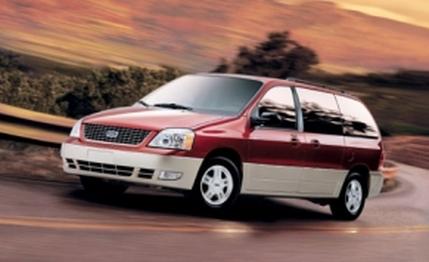
 First Drive Review
First Drive Review
The North American minivan market may not be growing much, but the number of market-share contenders is. Examples: Honda's Odyssey became the benchmark in 1999, the Kia Sedona came on in 2002 as an excellent value, the latest Nissan Quest adds a dash of daring design previously absent in vans, and the new Toyota Sienna raises the stakes in refinement.
There are others, of course, but the message is clear: If you're going to play in this game, you'd better be holding some trumps. Discounts, cash-back incentives, and fleet sales ain't enough. Behold the new Ford Freestar and its Mercury variant, the Monterey. Ford prefers "all-new" as a descriptor, but the unit-body bones were updated from the Ford Windstar, an also-ran in the minivan derby. Aside from a 2.7-inch-higher roofline, the chassis and body dimensions are all but identical with those of the old van, and the sheetmetal doesn't exactly represent a startling departure. Ford marketing types say styling is a secondary issue with minivans, which is plausible, but they also felt a new name was required to make sure buyers understand they're beholding newness rather than recycle.
On the other hand, new does apply here. The engineers reinforced the body shell from top to bottom; suspension components have been redesigned fore and aft; the pushrod V-6 engines-the base 3.9-liter and an upgrade 4.2-are new, at least in terms of displacement, output, and refinement; a broad range of sound-deadening measures make this van distinctly quieter; manufacturing-process enhancements at the plant in Oakville, Ontario, should produce a higher level of quality; and Ford has raised the ante in terms of passive safety.
This last-safety-was the Windstar's strongest suit. With top ratings (five stars) from NHTSA for front and side impacts, the Windstar lacked only the coveted "good" rating from the Insurance Institute for Highway Safety for offset frontal-impact performance to be as good as it gets in crashworthiness. Ford's safety engineers expect the Freestar to move the needle up the final notch, in addition to collecting max stars in the NHTSA ratings. They also expect the vans to provide improved protection in rollover crashes, with a new full-length curtain airbag system (optional in the Freestar, standard in the Monterey). When system sensors identify impending inversion, the bags inflate and stay inflated for six seconds, something new in passive safety for vans. There's also a smart front-passenger airbag system that governs deployment according to the passenger's weight, distance of the seat from the dash, and whether the seatbelt is buckled.
The interior of the Freestar is more visibly new than the skin, with a clean, understated instrument panel that's shared with the Monterey. There are all sorts of storage nooks and cubbies, including a lidded bin in the middle of the upper dash-a touch borrowed from Nissan-plus as many as 10 of the all-important cup holders.
Another borrowed idea-Honda's disappearing third-row seat-is used in the rear of Ford's new vans, with enhancements. Ford has rendered the stowage fingertip easy, and the seat snugs into the floor with its three headrests in place. Beyond that, a clever hinge system allows the seat to face backward for enhanced tailgate lounging.
Bench (standard) or bucket, the middle-row seats provide fore-and-aft adjustability as well as tumble folding. The captain's-style buckets are also removable, although at 70 pounds they're pretty hefty. With the seats configured for cram-it-full-to-the-rafters, max interior volume works out to just over 134 cubic feet, a little less than the Windstar's, although there's more storage space behind the third row.
Power-sliding side doors and liftgate are optional. A rear-seat DVD entertainment system continues to be a popular option, and there is a broad range of audio systems. However, neither van will offer satellite radio, at least at first, and a nav system is conspicuous by its absence.
Selective body-shell stiffening and the various decibel-diminishing tweaks add up at the scales. Ford describes curb weights as "up marginally," which translates as more than 320 pounds, per listed figures for both base minivans. And this, in turn, sops up performance, since engine output is largely unchanged. The old 3.8-liter V-6 was rated for 200 horsepower and 240 pound-feet of torque. The new 3.9 generates 193 horsepower and 245 pound-feet, 90 percent of it by 1500 rpm. At least the optional 4.2 (standard in the Monterey) is rated for 201 horsepower and 263 pound-feet. With a heavier van, acceleration feels pretty deliberate, a word that also applies to the Freestar's dynamics. But totally predictable applies, too, and with new all-disc brakes with standard ABS, plus brake assist, we expect to see an improvement in stopping performance when we get a Freestar to a test track.
The Freestar has five trim levels, from the base S, aimed at fleet sales, to the top-of-the-line Limited. Ford had no pricing specifics at press time, other than to say the Freestar would be "about the same" as the Windstar. That would mean a range of about $23,750 to $35,500, excluding options. At the same time, a marketing exec admitted there would "probably be incentives from the git-go," which is Detroit's way of doing business these days.
In any case, the corporate publicity mill claims the new Freestar-and, by association, the Monterey-"is designed to be Ford's best minivan ever." Which is very likely true. But will that be enough?